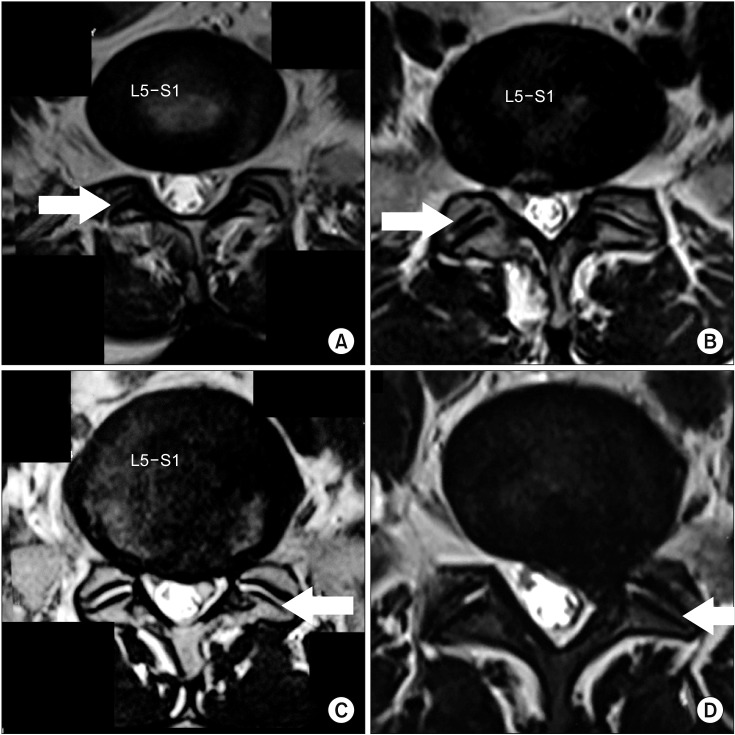Clin Orthop Surg.
2018 Jun;10(2):210-215. 10.4055/cios.2018.10.2.210.
Revalidating Pfirrmann's Magnetic Resonance Image-Based Grading of Lumbar Nerve Root Compromise by Calculating Reliability among Orthopaedic Residents
- Affiliations
-
- 1Department of Orthopaedic Surgery, Melmaruvathur Adhiparasakthi Institute of Medical Sciences and Research, Affiliated to the Tamil Nadu Dr MGR Medical University, Tamil Nadu, India. senthilbonearch@gmail.com
- 2Department of Orthopaedic Surgery, Chang Gung Memorial Hospital and Chang Gung University College of Medicine, Taoyuan, Taiwan.
- KMID: 2411747
- DOI: http://doi.org/10.4055/cios.2018.10.2.210
Abstract
- BACKGROUND
Intervertebral disc herniations lead to subsequent compromise of the nerve root. The root can either have a mere contact with the disc material or be pushed aside or compressed. This was earlier graded by Pfirrmann and colleagues. We intend to revalidate this grading system by performing a reliability analysis among orthopaedic residents.
METHODS
Fifty axial cut magnetic resonance (MR) images of the affected lumbar disc level that belonged to different patients (age, 37.8 ± 10.4 years; 33 males and 17 females) were chosen and given to five orthopaedic residents for grading according to the Pfirrmann's MR image-based grading of lumbar nerve root compromise. Responses were received in the form of categorical variables and reliability was assessed.
RESULTS
On doing percentage statistics, we found that 14 images had 100% agreement, 22 had 80% agreement and 14 had 60% agreement. We inferred an overall agreement of 80% ± 15.1%. In addition, interrater reliability was determined by calculating the Fleiss' kappa, which was found to be 0.521, signifying moderate agreement. Intrarater reliability was determined by calculating Cohen's kappa, which was found to be 0.696, signifying substantial agreement.
CONCLUSIONS
Our residents took only a short time to learn and reproduce this grading system as ratings that proved to be moderately reliable. Even though the value of kappa was slightly lower, reliability was similar to that of the original authors. We think that this grading system can be adopted in day-to-day practice by framing appropriate rules to interpret MR images where the nerve roots are not visible.
Figure
Cited by 1 articles
-
Spontaneous Total Resolution of Severe Lumbar Disc Herniation
Arun-Kumar Kaliya-Perumal, Jacob Yoong-Leong Oh
Chonnam Med J. 2020;56(1):77-78. doi: 10.4068/cmj.2020.56.1.77.
Reference
-
1. Takahashi N, Yabuki S, Aoki Y, Kikuchi S. Pathomechanisms of nerve root injury caused by disc herniation: an experimental study of mechanical compression and chemical irritation. Spine (Phila Pa 1976). 2003; 28(5):435–441. PMID: 12616153.2. Goupille P, Mulleman D, Valat JP. Radiculopathy associated with disc herniation. Ann Rheum Dis. 2006; 65(2):141–143. PMID: 16410526.
Article3. Rothman SM, Winkelstein BA. Chemical and mechanical nerve root insults induce differential behavioral sensitivity and glial activation that are enhanced in combination. Brain Res. 2007; 1181:30–43. PMID: 17920051.
Article4. Zhang S, Nicholson KJ, Smith JR, Gilliland TM, Syre PP, Winkelstein BA. The roles of mechanical compression and chemical irritation in regulating spinal neuronal signaling in painful cervical nerve root injury. Stapp Car Crash J. 2013; 57:219–242. PMID: 24435733.
Article5. Pfirrmann CW, Dora C, Schmid MR, Zanetti M, Hodler J, Boos N. MR image-based grading of lumbar nerve root compromise due to disk herniation: reliability study with surgical correlation. Radiology. 2004; 230(2):583–588. PMID: 14699183.
Article6. van Rijn JC, Klemetso N, Reitsma JB, et al. Observer variation in MRI evaluation of patients suspected of lumbar disk herniation. AJR Am J Roentgenol. 2005; 184(1):299–303. PMID: 15615992.
Article7. Li Y, Fredrickson V, Resnick DK. How should we grade lumbar disc herniation and nerve root compression? A systematic review. Clin Orthop Relat Res. 2015; 473(6):1896–1902. PMID: 24825130.
Article8. Landis JR, Koch GG. The measurement of observer agreement for categorical data. Biometrics. 1977; 33(1):159–174. PMID: 843571.
Article9. Brinjikji W, Luetmer PH, Comstock B, et al. Systematic literature review of imaging features of spinal degeneration in asymptomatic populations. AJNR Am J Neuroradiol. 2015; 36(4):811–816. PMID: 25430861.
Article10. Jensen MC, Brant-Zawadzki MN, Obuchowski N, Modic MT, Malkasian D, Ross JS. Magnetic resonance imaging of the lumbar spine in people without back pain. N Engl J Med. 1994; 331(2):69–73. PMID: 8208267.
Article11. Janardhana AP, Rajagopal , Rao S, Kamath A. Correlation between clinical features and magnetic resonance imaging findings in lumbar disc prolapse. Indian J Orthop. 2010; 44(3):263–269. PMID: 20697478.
Article12. Kaliya-Perumal AK, Yeh YC, Luo CA, Joey-Tan KY. Assessment of anteroposterior subpedicular approach and oblique scotty dog subpedicular approach for selective nerve root block. Clin Orthop Surg. 2017; 9(1):71–76. PMID: 28261430.
Article13. Salama AA, Alarabawy RA, Dawoud MM, Zayed HA, Soliman A, El-Tantawy A. Functional disability of occupational-related lumbar disc degeneration: evaluation by magnetic resonance imaging with surgical correlation. Egypt J Radiol Nucl Med. 2017; 48(1):189–199.
Article
- Full Text Links
- Actions
-
Cited
- CITED
-
- Close
- Share
- Similar articles
-
- Clinical and Radiological Findings of Nerve Root Herniation after Discectomy of Lumbar Disc Herniation
- Usefulness of the ProSet MRI for Diagnosis of the Extraforaminal Disc Herniation
- Reliable Magnetic Resonance Imaging Based Grading System for Cervical Intervertebral Disc Degeneration
- Diagnosis of Nerve Root Compromise of the Lumbar Spine: Evaluation of the Performance of Three-dimensional Isotropic T2-weighted Turbo Spin-Echo SPACE Sequence at 3T
- Reliability of MRI findings for Symptomatic Extraforaminal Disc Herniation in Lumbar Spine


